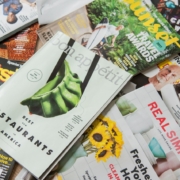Copywriters, own your copy.
A good copywriter will put their heart and soul into every piece copy they write — often spending hours crafting each paragraph and sentence and making sure every word is in perfect harmony with its brethren.
But it shouldn’t end there, because if you’re a writer, you should also be just as passionate about how your well written prose is displayed for all to see.
I’m probably a bit more passionate about this topic than most copywriters, mainly because I have been both an Art Director and Typographer before taking up the call of the written word.
It has always struck me that the best writers are the ones who care about their copy — well and truly after the client has given it the nod.
The passionate writers are the ones in the studio (normally after hours) with the Art Director/Designer and Studio artists fine tuning headlines and text so that it belongs on the page with all the other elements, and doesn’t look like a tacked on afterthought.
Young Art Directors/Designers in particular don’t seem to share the same love of typography as the previous generation. More emphasis seems to be placed on finding and photoshopping an image to suit a particular concept. Headlines and text seem to be secondary.
Well written, well targeted copy that provides a solution to client brief, deserves to be seen and read in context with the other elements in an overall creative execution.
As a writer, it’s your responsibility to see that what you’ve spent hours sweating away at, is depicted in a way that makes you proud enough to say, “I wrote that!”
So, what can you do make sure your copy not only reads well, but looks great too?
Here’s a look at just a few of the things that can affect your copy and a few hints to drop next time you’re in the Studio when they’re using your copy — be it for print, digital or broadcast media.
Fonts
The correct typeface selection can make all the difference to the legibility of your copy. Generally, a serif font is considered more legible than a san serif font if there is a lot of copy involved — great for long copy ads, magazine articles and books. San serif fonts are better if there is minimal copy, or if used in a minimalist layout with lots of open space. Steer clear of display-style fonts for text copy as these can be incredibly frustrating to try and read at smaller sizes. Ultimately though, an experienced Art Director/Designer will have a vision for the overall concept, so trust their judgement.
Point size
This goes hand in hand with typeface selection. The general rule of thumb is to make sure the point size of your text is a legible size so that it can be easily read by your target audience. As an example, there’s no point in having 8 or 9 point text for an ad targeting the elderly. It’s the single best way to lose an older customer.
Style
Keep to a regular, medium or light weight for text fonts and leave the bolds anditalics for your subheads and any emphasising text throughout your copy.

Paragraph setting
Essentially, there are only four options — flush left, flush right, centred and justified. Work closely with your Art Director/Designer to establish what looks good in the overall concept. Be wary though, trying to read a lot of copy in a centred layout doesn’t tend work. Likewise, copy in a large point size set in a justified layout will start to create ’rivers’ or ’snakes’. This is a visually intrusive white line effect running the length of a text block.
Line lengths and bad line breaks
Don’t make it hard for you audience to read your copy by setting it over a large line width. It strains the eyes and will probably strain the relationship with your target audience. Keep your copy to a width that is comfortable to read regardless of the point size. A general rule of thumb is to keep it to a word count of around 9-12 words per line if using a flush left layout, and slightly more at around 12-15 words per line in a justified setting.
Colour
Let common sense prevail here. Your copy should contrast with whatever background it sits on. Light coloured text on a light background is incredibly hard to read. Likewise dark text on dark backgrounds. Again, make it so that your reader has every chance to to easily understand your message.
Widows and orphans
No one likes seeing a single word on its lonesome. Worst still is the hyphenated word at the end of a paragraph which is split so that the end sits forlorn on a line by itself, while its front gets to enjoy the company of other words in the line above. Rework the copy so that there are additional words to pad out the line length, or lose a word or two so that the widowed line falls back to the line above.
Paragraph spacing/Indents
 If there is a lot of copy, you have the choice of breaking up the flow of thought by either using an indent at the beginning of each paragraph, or by using a small amount of spacing between paragraphs. Ask a group of Art Directors/Designers what they prefer and you’ll get varying answers. Some believe indents should only be used for books and magazines and para spacing used for advertising and digital copy. Really though, it’s a matter of aesthetics, because using either option works.
If there is a lot of copy, you have the choice of breaking up the flow of thought by either using an indent at the beginning of each paragraph, or by using a small amount of spacing between paragraphs. Ask a group of Art Directors/Designers what they prefer and you’ll get varying answers. Some believe indents should only be used for books and magazines and para spacing used for advertising and digital copy. Really though, it’s a matter of aesthetics, because using either option works.
Kerning
Bad kerning will generally show itself in headlines that are set in a large point size. It will be obvious because you’ll be able to drive a bus between some of the letters. I’ve seen kerning so bad that the space between the letters created two distinct words. Anyway, be mindful of your headlines and make sure it looks evenly spaced. Look out for bad relationships between capital letters with their own ’white space’ (A, C, F, J, L, P, T, V, W, Y), and other letters either side within a word. Again, your Art Director/Designer is the go-to guy here and he will be able to direct the studio artists as to what is aesthetically pleasing.
Call to action and contact details
Probably the most important part of any communication especially if the ad/flyer/website is advertising a product or a service. Don’t be shy with bold telephone numbers and website links. It doesn’t necessarily have to be larger than the rest of the text, just emphasise it in a way that compliments the overall concept.
Obviously these factors will vary tremendously every time a new piece of communication is created. The message here is to take an interest in how your copy is going to be seen by your intended audience. Talk to your Art Director/Designer and make him/her aware of your concerns if you think the layout of the communication piece is not doing justice to your copy.
Remember, your copy is a vital element to any communication and deserves to portrayed in a way that is easily read and understood.
About the author: Steve Williss

Steve Williss has been a Studio Artist, Studio Manager, Typographer and Art Director before taking up the call to pen the copy he has crafted so often over the years. He is currently owner and go-to guy at WriteMind — a writing, communications, and ideas business based in Adelaide, South Australia.




(This is a great primer on using type. What I would add to it is selecting the type style that feels organic to the actual message the type will be expressing.
I’ve always loved type. It has its own soul, it’s own mood. When it feels like it’s ‘part of the family’ of the message, you feel like it’s twice as strong a message.
Type is also art. I could watch a video on different fonts in different settings of scenario. Don’t you find yourself critiquing the title art of films? I think that’d be a great job! I’ve been a writer, never got into design. Love what I’ve done all these years. Received a few dozen awards. I’m semi-retired now, and actually miss it, but I take on headline and tagline gigs now, no body copy anymore. I’m glad you love what you do as much as you do! It’s such
a good mental exercise and keeps your ‘thinking muscle’ memory fresh as new.
Best wishes for 2016! Judy B. David You Aussies are marvelous. I’ve never been there but everyone seems to be so engaging. (Ignore my neglected half-done web site–I’m embarrassed I haven’t finished it!)